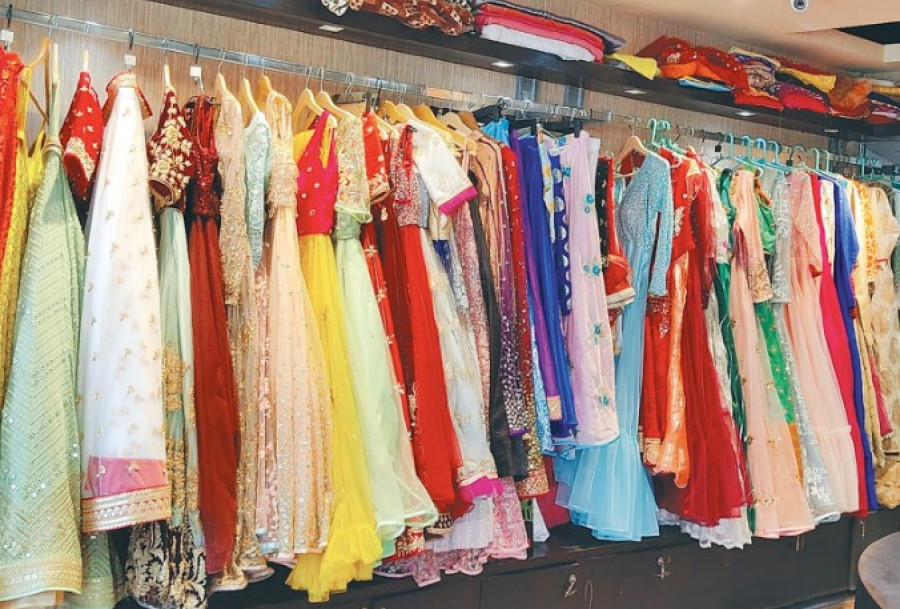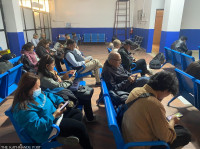Money
Boutiques in Kupondole lose shine as recession bites
The decline in disposable incomes of the people, mainly the middle class, has dampened the demand for luxury clothing.
Sarahna Khadka
Nari Villa, a roadside boutique in Kupondole, lies deserted nowadays. The boutique owner is preparing to shut down the business, which opened five years ago.
The reason: poor sales.
“The sales have come to a rock bottom. It’s 10 percent of what it used to be a few years ago. We cannot even cover the operating costs nowadays,” Jenisha Shyangbo, an employee of the boutique, told the Post.
The lost revenue comes at the most pivotal time in Dashain when regular price selling used to soar. The worst-than-expected sales during the Dashain festival this year have significantly impacted the business, putting most of the enterprises into the red.
Two decades ago, Kupondole emerged as the boutique hub of the Kathmandu Valley, setting a pattern in the domestic fashion market at a time when imported readymade garments were rampant.
In their long journey, boutiques faced many challenges.
Making their way out of Covid was more difficult for apparel retailers.
With so many people out of work during the pandemic, prices were slashed significantly.
Then the online sales started. Boutique owners were further disappointed as they did not think it was a wise decision to sell the premium products via online mediums like TikTok.
Kupondole was still teeming with indulgent boutiques with fancy clothes on display.
Boutique apparel costs range from Rs5,000 to Rs100,000.
“Businesses that operate via online mediums like Facebook and TikTok do not incur costs of rent and do not have to pay for workers. They can price their products much lower compared to our businesses. We still display products in the stores and pay hefty rents,” said Menaka Sanil, who has been running Silai Boutique since 2017.
She had opened Silai Boutique in Kupondole after two other boutiques in separate locations in the valley.
“As online thrived, prices became lower,” she said.
Now, the recession is biting them all.
“The customers are not visiting the boutique shops,” said Sanil.
“We have estimated annual sales of Rs2.5 million and based on the trend, it looks like we can't even make one-third of the estimated revenue,” said Sanil.
Most of the boutiques reported a sharp drop in sales during the September-November period—the key sales period—and expected more drop in sales.
Sanil fears that the current economy of the country would put all boutiques on the edge. She is also planning to shut her store.
The country’s economy is under severe stress.
Nepal’s growth decreased to an estimated 1.9 percent in the last fiscal year, the lowest rate since 2019-20 and substantially below the 10-year average growth rate, the World Bank said in its recent Nepal Development Update.
Economic activity was particularly subdued in the industry and services sectors.
When the Covid pandemic hit, owners were forced to close their shops for several months.
The lockdowns ended and the business began to rebound slowly.
But the recovery didn’t last.
During the festive season, ‘sale’ posters were common at apparel stores as they tried to attract buyers amid a drop in consumer spending, primarily because of inflationary pressures.
Now, they are displaying ‘To Let’ signs.
Empty shops began appearing on the streets of Kathmandu since the start of the credit crunch. In other cities in Nepal too, a large number of shops lie vacant as the recession has exacerbated other problems, such as rising rents and reduced customer footfall.
Although the banks say that they are now awash with funds, there are no borrowers.
Traders say that rising rentals of showrooms, bank interest rates and low sales are driving them out of business.
Dealers say as customer income has dropped due to the slowdown in the economy, there is a slump in demand for high-fashion traditional clothes such as lehenga, saree and kurta.
Global inflation, too, affected the profit margins.
Some boutique owners are optimistic the upcoming wedding season will help them recover from the slowdown.
Binisha Manandhar, who has been operating Yasin Siddique Boutique since 2013, is optimistic about the upcoming wedding season as boutiques offer bridal sets. The prices range from Rs5,000 to Rs70,000, depending on quality.
“There are few orders coming.”
Manandhar said her boutique incurs prominent costs for the salaries of tailoring masters and embroidering labourers. “Customers, obviously, look for unique designs and elaborate embroidery,” said Manandhar.
According to Manandhar, they have to source high-quality materials from abroad. The prices of the raw materials too have peaked to record highs.
Most boutiques are owned and operated by women.
Sangee’s Apparel Studio, established in Jwagal a decade and a half ago, became popular in a short span of time in Kupondole. But nowadays, it has been struggling.
“Our sales are seasonal. We didn’t have sales in festivals like Dashain and Tihar,” said Sangeeta Sharma, designer and manager at the studio. “But since the wedding season has now begun, we are busy.”
According to her, bridal sets are, too, the key for business.
“Normally, brides order a set including saree for wedding, lehenga for receptions, and kurti for other rituals. These sets for a bride can go up to Rs200,000.”




 15.12°C Kathmandu
15.12°C Kathmandu















